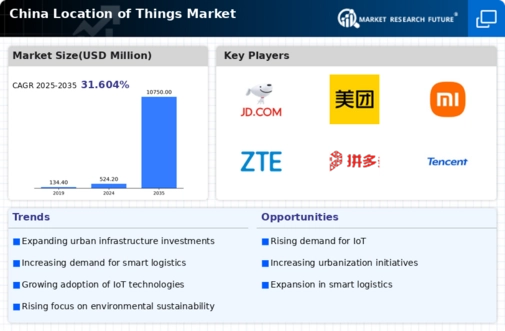Rapid Urbanization
The rapid urbanization in China is a crucial driver for the location of-things market. As urban populations swell, the demand for efficient location-based services increases. In 2025, urban areas in China are projected to house over 60% of the population, necessitating advanced location technologies to manage urban infrastructure effectively. This urban growth fuels the need for smart transportation systems, real-time navigation, and location-aware applications, which are integral to the location of-things market. Furthermore, the Chinese government has invested heavily in urban development projects, which often incorporate location-based technologies to enhance city management and improve residents' quality of life. The integration of these technologies is expected to create a market worth billions, as businesses and municipalities seek to leverage location data for better decision-making.
Rising Demand for Real-Time Data
The rising demand for real-time data is a significant driver of the location of-things market in China. As businesses and consumers increasingly seek immediate access to information, the need for real-time location data has become paramount. Industries such as logistics, retail, and transportation are particularly affected, as they rely on accurate location information to enhance operational efficiency and customer satisfaction. In 2025, the market for real-time location systems in China is projected to reach $8 billion, reflecting the growing reliance on location data for decision-making. This trend is further supported by the proliferation of mobile devices and the Internet of Things (IoT), which facilitate the collection and dissemination of real-time location information. Consequently, the location of-things market is likely to experience robust growth as organizations invest in technologies that provide timely and actionable insights.
Government Initiatives and Regulations
Government initiatives and regulations play a pivotal role in shaping the location of-things market in China. The Chinese government has launched various policies aimed at promoting the adoption of location-based technologies across multiple sectors, including transportation, healthcare, and public safety. For instance, the implementation of the National Spatial Data Infrastructure (NSDI) aims to standardize location data usage, enhancing interoperability among different systems. This regulatory framework is expected to drive market growth, as it encourages businesses to invest in location technologies to comply with new standards. Additionally, the government's focus on enhancing data privacy and security in location services is likely to foster consumer trust, further propelling the adoption of these technologies. As a result, the location of-things market is anticipated to expand significantly, with investments reaching upwards of $10 billion by 2027.
Increased Investment in Smart Infrastructure
Increased investment in smart infrastructure is driving the location of-things market in China. The government and private sector are channeling substantial resources into developing smart cities, which integrate location-based technologies to enhance urban living. By 2025, investments in smart infrastructure are expected to surpass $200 billion, focusing on transportation, energy management, and public safety. This investment is likely to create a robust ecosystem for location-based services, as smart infrastructure relies heavily on accurate location data for functionality. For instance, smart traffic management systems utilize real-time location data to optimize traffic flow and reduce congestion. As these initiatives gain momentum, the location of-things market is anticipated to flourish, with numerous opportunities for innovation and growth in various sectors.
Technological Advancements in GPS and Mapping
Technological advancements in GPS and mapping technologies are significantly influencing the location of-things market in China. Innovations such as high-precision GPS and advanced mapping algorithms are enhancing the accuracy and reliability of location-based services. In 2025, the market for GPS technology in China is expected to exceed $5 billion, driven by the increasing demand for precise location data in various applications, including autonomous vehicles and logistics. These advancements enable businesses to optimize their operations, improve customer experiences, and reduce costs. Moreover, the integration of artificial intelligence with location technologies is likely to create new opportunities for innovation within the market. As companies leverage these advancements, the location of-things market is poised for substantial growth, with a projected CAGR of over 20% in the coming years.

























Leave a Comment